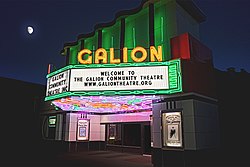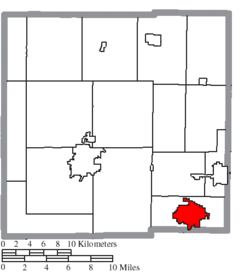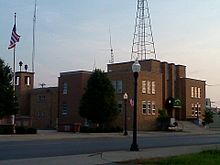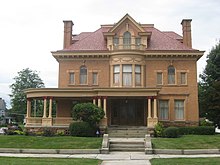Galion, Ohio: Difference between revisions
JonRidinger (talk | contribs) m →Adam Howard House: convert template |
m →History |
||
| Line 84: | Line 84: | ||
==History== |
==History== |
||
Galion was laid out in 1831.<ref>{{cite book | url=https://archive.org/details/bub_gb_a-MyAQAAMAAJ | title=History of Crawford County and Ohio | publisher=Baskin & Battey | year=1881 | pages=[https://archive.org/details/bub_gb_a-MyAQAAMAAJ/page/n430 444]}}</ref> However, in 1824 the town petitioned for a post office using the name Goshen and later changed to Galion by the postmaster general, [[John McLean]], due to a town already being named [[Goshen, Ohio|Goshen]] in Ohio.<ref name=":1">{{Cite book|last=Mansfield|first=Bernard|url=https://books.google.com/books?id=qQ2LAAAAQBAJ&newbks=0&printsec=frontcover&pg=PT41&hl=en|title=The Olentangy Legacy: Book Two|date=2010-06-01|publisher=Xlibris Corporation|isbn=978-1-4691-0114-9|language=en}}</ref> The etymology of the name Galion is uncertain.<ref>{{cite book|last=Overman|first=William Daniel|title=Ohio Town Names|url=https://babel.hathitrust.org/cgi/pt?id=mdp.39015015361465;view=1up;seq=65|year=1958|publisher=Atlantic Press|location=Akron, OH|page=49}}</ref> A post office called Galion has been in operation since 1825.<ref>{{cite web |url=http://www.postalhistory.com/postoffices.asp?state=OH |title=Post offices |publisher=Jim Forte Postal History |access-date=11 June 2016 |url-status=dead |archive-url=https://web.archive.org/web/20151013181747/http://www.postalhistory.com/postoffices.asp?state=OH |archive-date=13 October 2015 }}</ref> |
The region was first inhabited by Native American tribes up until the first settlers, Benjamin Leveridge and his two sons, arrived in 1817. In 1820, William Hosford and his two sons, Asa and Horace, settled on land outside of the area. It was not until Colonel [[James Kilbourne]] decided to "lay out a town half way between Columbus and the Lakes" that the crossroads of Portland and Main street were settled by the the Hosford family.<ref name=":0">{{Cite book|last=Hopley|first=John E. (John Edward)|url=http://archive.org/details/cu31924012523464|title=History of Crawford County, Ohio, and representative citizens|date=1912|publisher=Chicago,Ill., Richmond-Arnold Publishing Company|others=Cornell University Library}}</ref> This crossing was known by various names including: Moccasin, Horseshoe, Hard Scrabble, Spang Town, Hosfords and Goshen.<ref name=":0" /> Galion was laid out in 1831.<ref>{{cite book | url=https://archive.org/details/bub_gb_a-MyAQAAMAAJ | title=History of Crawford County and Ohio | publisher=Baskin & Battey | year=1881 | pages=[https://archive.org/details/bub_gb_a-MyAQAAMAAJ/page/n430 444]}}</ref> However, in 1824 the town petitioned for a post office using the name Goshen and later changed to Galion by the postmaster general, [[John McLean]], due to a town already being named [[Goshen, Ohio|Goshen]] in Ohio.<ref name=":1">{{Cite book|last=Mansfield|first=Bernard|url=https://books.google.com/books?id=qQ2LAAAAQBAJ&newbks=0&printsec=frontcover&pg=PT41&hl=en|title=The Olentangy Legacy: Book Two|date=2010-06-01|publisher=Xlibris Corporation|isbn=978-1-4691-0114-9|language=en}}</ref> The etymology of the name Galion is uncertain.<ref>{{cite book|last=Overman|first=William Daniel|title=Ohio Town Names|url=https://babel.hathitrust.org/cgi/pt?id=mdp.39015015361465;view=1up;seq=65|year=1958|publisher=Atlantic Press|location=Akron, OH|page=49}}</ref> A post office called Galion has been in operation since 1825.<ref>{{cite web |url=http://www.postalhistory.com/postoffices.asp?state=OH |title=Post offices |publisher=Jim Forte Postal History |access-date=11 June 2016 |url-status=dead |archive-url=https://web.archive.org/web/20151013181747/http://www.postalhistory.com/postoffices.asp?state=OH |archive-date=13 October 2015 }}</ref> |
||
Asa Hosford is considered the "Father of Galion" due to his work as a state legislator in which he did work to get a rail line through the area that was completed in 1851.<ref name=":2" /> |
Asa Hosford is considered the "Father of Galion" due to his work as a state legislator in which he did work to get a rail line through the area that was completed in 1851.<ref name=":2" /> |
||
Revision as of 20:57, 11 February 2021
Galion, Ohio | |
|---|---|
 The Galion Theatre located on Harding Way West in uptown Galion | |
 Location of Galion, Ohio | |
 Location of Galion in Crawford County | |
| Coordinates: 40°43′59″N 82°47′19″W / 40.73306°N 82.78861°W | |
| Country | United States |
| State | Ohio |
| Counties | Crawford, Morrow, Richland[1] |
| Government | |
| • Type | Mayor-Council |
| • Mayor | Mayor Tom O'Leary |
| Area | |
| • Total | 7.41 sq mi (19.20 km2) |
| • Land | 7.39 sq mi (19.15 km2) |
| • Water | 0.02 sq mi (0.05 km2) |
| Elevation | 1,171 ft (357 m) |
| Population | |
| • Total | 10,512 |
| • Estimate (2019)[5] | 9,982 |
| • Density | 1,350.20/sq mi (521.28/km2) |
| Time zone | UTC-5 (Eastern (EST)) |
| • Summer (DST) | UTC-4 (EDT) |
| ZIP code | 44833 |
| Area code | 419 |
| FIPS code | 39-29162[6] |
| GNIS feature ID | 1064699[3] |
| Website | http://www.galion.city |
Galion is a city in Crawford, Morrow, and Richland counties in the U.S. state of Ohio. The population was 10,512 at the 2010 census. Galion is the second-largest city in Crawford County after Bucyrus.
The Crawford County portion of Galion is part of the Bucyrus Micropolitan Statistical Area. The small portion of the city that is located in Richland County is part of the Mansfield Metropolitan Statistical Area, while the portion extending into Morrow County is considered part of the Columbus Metropolitan Statistical Area.
History
The region was first inhabited by Native American tribes up until the first settlers, Benjamin Leveridge and his two sons, arrived in 1817. In 1820, William Hosford and his two sons, Asa and Horace, settled on land outside of the area. It was not until Colonel James Kilbourne decided to "lay out a town half way between Columbus and the Lakes" that the crossroads of Portland and Main street were settled by the the Hosford family.[7] This crossing was known by various names including: Moccasin, Horseshoe, Hard Scrabble, Spang Town, Hosfords and Goshen.[7] Galion was laid out in 1831.[8] However, in 1824 the town petitioned for a post office using the name Goshen and later changed to Galion by the postmaster general, John McLean, due to a town already being named Goshen in Ohio.[9] The etymology of the name Galion is uncertain.[10] A post office called Galion has been in operation since 1825.[11]
Asa Hosford is considered the "Father of Galion" due to his work as a state legislator in which he did work to get a rail line through the area that was completed in 1851.[12]
Ohio Central Traction Company, an interurban line that connected the two communities of Bucyrus and Galion, developed Seccaium Park at the end of the Nineteenth Century.
Galion is home of The Galion Graders a member of the Great Lakes Summer Collegiate Baseball League. The GLSCBL is a wooden bat league for college athletes looking to further improve on their great skill. The Graders specifically focus on doing this while providing a fun, family oriented experience for its fans and their communities.[13]
Geography
Galion is located in the southeastern corner of Crawford County at 40°43′59″N 82°47′19″W / 40.73306°N 82.78861°W (40.733164, -82.788586).[14]
According to the United States Census Bureau, the city has a total area of 7.63 square miles (19.76 km2), of which 7.61 square miles (19.71 km2) is land and 0.02 square miles (0.05 km2) is water.[15]
The Olentangy River begins near and runs through Galion, and then winds southward toward Columbus and eventually empties into the Scioto River.
Demographics


| Census | Pop. | Note | %± |
|---|---|---|---|
| 1860 | 1,966 | — | |
| 1870 | 3,523 | 79.2% | |
| 1880 | 5,635 | 59.9% | |
| 1890 | 6,326 | 12.3% | |
| 1900 | 7,282 | 15.1% | |
| 1910 | 7,214 | −0.9% | |
| 1920 | 7,374 | 2.2% | |
| 1930 | 7,674 | 4.1% | |
| 1940 | 8,685 | 13.2% | |
| 1950 | 9,952 | 14.6% | |
| 1960 | 12,650 | 27.1% | |
| 1970 | 13,123 | 3.7% | |
| 1980 | 12,424 | −5.3% | |
| 1990 | 11,859 | −4.5% | |
| 2000 | 11,341 | −4.4% | |
| 2010 | 10,512 | −7.3% | |
| 2019 (est.) | 9,982 | [5] | −5.0% |
| Sources:[6][16][17] | |||
2010 Census
As of the census[4] of 2010, there were 10,512 people, 4,484 households, and 2,797 families living in the city. The population density was 1,381.3 inhabitants per square mile (533.3/km2). There were 5,192 housing units at an average density of 682.3 per square mile (263.4/km2). The racial makeup of the city was 97.6% White, 0.5% African American, 0.1% Native American, 0.2% Asian, 0.4% from other races, and 1.1% from two or more races. Hispanic or Latino of any race were 1.3% of the population.
There were 4,484 households, of which 30.8% had children under the age of 18 living with them, 43.7% were married couples living together, 14.2% had a female householder with no husband present, 4.5% had a male householder with no wife present, and 37.6% were non-families. 32.0% of all households were made up of individuals, and 13.8% had someone living alone who was 65 years of age or older. The average household size was 2.32 and the average family size as 2.89.
The median age in the city was 39.7 years. 24.3% of residents were under the age of 18; 8.2% were between the ages of 18 and 24; 24.6% were from 25 to 44; 25.7% were from 45 to 64; and 17.3% were 65 years of age or older. The gender makeup of the city was 47.1% male and 52.9% female.
2000 Census
As of the census[6] of 2000, there were 11,341 people, 4,791 households, and 3,090 families living in the city. The population density was 2,286.5 people per square mile (882.8/km2). There were 5,150 housing units at an average density of 1,038.3 per square mile (400.9/km2). The racial makeup of the city was 98.28% White, 0.22% African American, 0.31% Native American, 0.26% Asian, 0.01% Pacific Islander, 0.35% from other races, and 0.56% from two or more races. Hispanic or Latino of any race were 0.93% of the population.
There were 4,791 households, out of which 31.0% had children under the age of 18 living with them, 48.3% were married couples living together, 12.2% had a female householder with no husband present, and 35.5% were non-families. 30.7% of all households were made up of individuals, and 13.6% had someone living alone who was 65 years of age or older. The average household size was 2.34 and the average family size was 2.90.
In the city the population was spread out, with 25.5% under the age of 18, 8.5% from 18 to 24, 27.8% from 25 to 44, 22.2% from 45 to 64, and 16.0% who were 65 years of age or older. The median age was 37 years. For every 100 females, there were 85.6 males. For every 100 females age 18 and over, there were 82.7 males.
The median income for a household in the city was $31,513, and the median income for a family was $38,554. Males had a median income of $32,517 versus $19,792 for females. The per capita income for the city was $16,113. About 11.9% of families and 14.7% of the population were below the poverty line, including 19.6% of those under age 18 and 11.3% of those age 65 or over.
Government
Galion has a Mayor-Council government: it is governed by an elected city council and mayor.[18] Thomas O’Leary has served as mayor since 2013.[19][20]
Education
The Galion City School District encompasses the entire city of Galion, graduating about 150 students annually.[21] There are a handful of neighborhoods outside of Galion that are also included in the school district, including Blooming Grove. Galion High School serves students ranging from grades 9 through 12. The school colors are blue and orange and its athletic teams are known as the Tigers. The current high school building opened in 2007 following the demolition of the previous home of Galion High School on North Union Street.

The first Galion Union High School was built in 1868 on West Walnut Street and served as Galion High School until 1917. This building was demolished in 1924 and a new junior high school was built on the site in 1925, which was razed in April 2008. The second home of GHS was built in 1917 on the site of a former cemetery on North Union Street. This building was extended in 1962, adding features such as a large gymnasium. This building was in use until the end of the 2006–2007 school year, with the new Galion High School opening in late 2007.
Media
Galion and neighboring communities are served by a semi-weekly newspaper, the Galion Inquirer.[22] The city's first newspaper, The District Democrat, was founded in 1855 and later sold and renamed The Galion Train.[9]
Parks and Recreation
Festivals
Every year the City of Galion hosts two major festivals: The Oktoberfest and the Pickle Run Festival.
Pickle Run Festival
The Pickle Run Festival began in 1961 and was said to have been inspired "when a grocer used to dump his old pickles into the Whetstone Creek behind his store and the pickles would run through the creek."[23] The festival would include events like the Pickle Run 5k, car show, watermelon diving competition along with carnival rides and food vendors among other things. The Pickle Run did not run from 1998 up till 2015 when volunteers started the Pickle Run festival over moving the original date on Labor Day to the Fourth of July weekend.
Oktoberfest
Started by the Galion Jaycess in 1976 and later ran by the local Moose Lodge, the Galion Oktoberfest is the city's fall festival that runs on the last weekend of September in the city's Uptowne Business District.[24] This three day event features a carnival with rides and vendors as well as live music.
Transportation


The Erie Railroad also ran through Galion and established large rail yards here, making the city an important rail center. In April, 1851 the Cleveland Columbus and Cincinnati Railroad, later known as the "Big Four" and eventually the New York Central, began operating regular service between Columbus and Cleveland, stopping at Galion along the way.[25] Prior to the end of the 19th century, Galion became a division headquarters for the line.
Galion once boasted two large railroad depots, the Big Four Depot on Washington Street, and the Erie Depot on South Market Street, which was torn down in 1986 due to its poor condition, after having served as a maintenance office for Conrail. With the move of the Erie yards to Marion in the 1910s, the railroads declined, although the city remained a passenger rail center into the 1960s. The Big Four Depot was abandoned; however, it has since been acquired by the City of Galion and is undergoing a slow but thorough restoration.
From 1915 to 1923, Galion was on the original route of the Lincoln Highway, America's first coast-to-coast route. In later years, however, the northern route was improved and became US 30 North, although until approximately 1970 the route through Galion was designated as US 30 South. The new, four-lane US 30 opened in 2005, and passes just north of town, giving the community excellent transportation access.
State routes in Galion include 309, which connects Marion to the southwest with Ontario to the east; 598, which originates in Galion and stretches northward; 19, which heads westward toward the county seat and also south toward Williamsport; 61, which goes south towards Morrow and Delaware Counties and north to Lake Erie, and 97, which goes east through Lexington.
Historic landmarks
Adam Howard House

Home of the founder of the Galion Buggy Company, the house was listed on the National Register of Historic Places on March 30, 1978 and is located on South Boston Street. The 7,200-square-foot (670 m2) home was built in 1898 and was later owned by the Galion Historical Society and sat vacant for 50 years until its auction to Tim and Connie Musselman in 2015.[26] The Victorian-era house features "massive pillars on the front porch, a golden oak vestibule and carved stairs leading to a circular balustrade and ballroom, all illuminated by a stained-glass skylight."[27]
Brownella Cottage and Grace Episcopal Church and Rectory
Brownella Cottage and Grace Episcopal Church and Rectory is a historic church complex at S. Union and Walnut Streets.
The site is significant for its association with Bishop William Montgomery Brown, notable as the first bishop of his communion to be tried for heresy since the Reformation and "'the first of any creed in America to be deposed for heretical teaching'".
The complex includes:
- the Brownella Cottage, built during 1885-1887 for Brown and his wife, Ella Scranton Bradford, which was the bishop's home until his death in 1937
- the bishop's study, formerly St. Joseph's Roman Catholic Church
- the Brownella carriage house
- Grace Episcopal Church
- the rectory of the Grace Episcopal Church
Central Hotel, Hackedorn and Zimmerman Building

The Central Hotel is a combination of three buildings that are "all that remains of Galion's significant commercial boom in the 1860's." [28]The Central Hotel was registered on the National Historic Registry on Nav.13, 1976 but did not see any significant improvements until it was procured by the Ohio Capital Corporation for Housing in 2004.[29] The non-profit led a significant restructuring and investment into the building and the building is now an affordable housing for seniors.[30]

Hosford House
The Hosford House was built in 1892 by Asa Hosford and listed on the National Historic Registry on April 30, 1976. Asa Hosford is considered the "Father of Galion" due to his work as a state legislator in which he did work to get a rail line through the area that was completed in 1851.[12]
Industry


The Galion brand of heavy equipment, such as road graders, road rollers, and earthmovers, was manufactured by Galion Iron Works, later purchased by Dresser Industries and then by Komatsu.
Galion was once the home of Peabody Galion, a manufacturer of sanitation equipment, primarily dump bodies, as well as front loading, side-loading and rear loading garbage trucks; rivaling the Heil Company for numbers of units sold throughout the world. For a short time, in the early 1970s, Peabody Galion maintained a manufacturing plant in Durant, Oklahoma, known as "Peabody Galion, Durant Division".
Galion was also once home to North Electric Company, a prime supplier of telephone switching systems for government and international markets. It was also producer of the Ericofon, the first ever one-piece telephone designed by Ralph Lysell and Hugo Blomberg.[31] Founded in 1884 by Charles N. North, the company became part of Ericsson in 1951. It was purchased by ITT in the mid-1970s and operated as ITT PowerSystems until the late 1980s, when it was sold to a private consortium and renamed PECO II (the name is derived from North Electric Company's purchase of Power Equipment Company (PECO) in 1960). Peco II purchased the telecommunications product line and associated assets from ITT in 1988. In 2010, PECO II was acquired by Lineage Power of Plano, Texas and has since closed the plant.
Notable Residents
- Logan Bartholomew (born February 9, 1984) actor born in Galion, best known for his role of Willie LaHaye in the Love Comes Softly series
- Julius H. Block, Minnesota State Treasurer, was born in Galion
- William Montgomery Brown, Episcopal clergyman and author, lived in Galion
- Florence Kling Harding, First Lady of the United States, lived in Galion with her first husband, Henry ("Pete") DeWolfe
- Henry David Lee, founder of the HD Lee Mercantile Company, inventors of Lee Jeans, lived in and operated a business in Galion
- Robert W. Morgan, radio personality, was from Galion
- Orville Nave, theologian and chaplain, was born in Galion
- Nate Reinking, professional basketball player for the British Basketball League and the Great Britain men's national basketball team; head coach in the NBA G League
- Bob Schnelker, professional football player in the National Football League
- JB Shuck, professional baseball player in Major League Baseball, raised in Galion and attended Galion High School
References
- ^ "Subcounty population estimates: Ohio 2000-2008". United States Census Bureau, Population Division. 2009-03-18. Archived from the original (CSV) on 2009-03-31. Retrieved 2009-04-04.
- ^ "2019 U.S. Gazetteer Files". United States Census Bureau. Retrieved July 28, 2020.
- ^ a b "US Board on Geographic Names". United States Geological Survey. 2007-10-25. Retrieved 2008-01-31.
- ^ a b "U.S. Census website". United States Census Bureau. Retrieved 2013-01-06.
- ^ a b "Population and Housing Unit Estimates". Retrieved May 21, 2020.
- ^ a b c "U.S. Census website". United States Census Bureau. Retrieved 2008-01-31.
- ^ a b Hopley, John E. (John Edward) (1912). History of Crawford County, Ohio, and representative citizens. Cornell University Library. Chicago,Ill., Richmond-Arnold Publishing Company.
- ^ History of Crawford County and Ohio. Baskin & Battey. 1881. pp. 444.
- ^ a b Mansfield, Bernard (2010-06-01). The Olentangy Legacy: Book Two. Xlibris Corporation. ISBN 978-1-4691-0114-9.
- ^ Overman, William Daniel (1958). Ohio Town Names. Akron, OH: Atlantic Press. p. 49.
- ^ "Post offices". Jim Forte Postal History. Archived from the original on 13 October 2015. Retrieved 11 June 2016.
- ^ a b "Historic Places | Galion, OH - Official Website". www.ci.galion.oh.us. Retrieved 2021-02-09.
- ^ "About". 2016-06-16. Retrieved 2021-02-08.
- ^ "US Gazetteer files: 2010, 2000, and 1990". United States Census Bureau. 2011-02-12. Retrieved 2011-04-23.
- ^ "US Gazetteer files 2010". United States Census Bureau. Archived from the original on 2012-07-02. Retrieved 2013-01-06.
- ^ "Number of Inhabitants: Ohio" (PDF). 18th Census of the United States. U.S. Census Bureau. 1960. Retrieved 24 April 2020.
- ^ "Ohio: Population and Housing Unit Counts" (PDF). U.S. Census Bureau. Retrieved 22 November 2013.
- ^ "City Council | Galion, OH - Official Website". www.ci.galion.oh.us. Retrieved 2017-08-17.
- ^ Smalley, Krystal. "Three candidates vie for Galion mayor". Richland Source. Retrieved 2017-12-06.
- ^ Jones, Noah. "Continuity in Galion; Mayor, law director & auditor re-elected". Richland Source. Retrieved 2017-12-06.
- ^ "Pages - District-Report". reportcard.education.ohio.gov. Retrieved 2017-08-17.
- ^ "About Us". Galion Inquirer. Retrieved 25 July 2017.
- ^ Furr, Jake. "Galion's Pickle Run to return after 17-year absence". Mansfield News Journal. Retrieved 2021-02-08.
- ^ Tuggle, Zach. "Galion Oktoberfest returns through Saturday after hiatus". Mansfield News Journal. Retrieved 2021-02-08.
- ^ Murphy, Ared Maurice (1925-06-01). "The Big Four Railroad in Indiana". Indiana Magazine of History. ISSN 1942-9711.
- ^ Davis, Rhonda; September 19, CCN Correspondent; Am, 2019 9:53. "Historic home a dream house for longtime neighbor". Crawford County Now. Retrieved 2021-02-09.
{{cite web}}:|first2=has generic name (help);|first3=has numeric name (help)CS1 maint: numeric names: authors list (link) - ^ Davis, Rhonda; September 19, CCN Correspondent; Am, 2019 9:53. "Historic home a dream house for longtime neighbor". Crawford County Now. Retrieved 2021-02-09.
{{cite web}}:|first2=has generic name (help);|first3=has numeric name (help)CS1 maint: numeric names: authors list (link) - ^ "Historic Places | Galion, OH - Official Website". www.ci.galion.oh.us. Retrieved 2021-02-09.
- ^ Reporter, Brittany Schock, Staff. "Galion's Central Hotel shows off significant renovations". Richland Source. Retrieved 2021-02-09.
{{cite web}}: CS1 maint: multiple names: authors list (link) - ^ Reporter, Brittany Schock, Staff. "Galion's Central Hotel shows off significant renovations". Richland Source. Retrieved 2021-02-09.
{{cite web}}: CS1 maint: multiple names: authors list (link) - ^ "ericofon.com - Old Case North Electric Ericofons". www.ericofon.com. Retrieved 2017-08-17.



